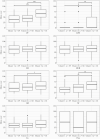Identification of Distinct Long COVID Clinical Phenotypes Through Cluster Analysis of Self-Reported Symptoms
- PMID: 35265728
- PMCID: PMC8900926
- DOI: 10.1093/ofid/ofac060
Identification of Distinct Long COVID Clinical Phenotypes Through Cluster Analysis of Self-Reported Symptoms
Abstract
Background: We aimed to describe the clinical presentation of individuals presenting with prolonged recovery from coronavirus disease 2019 (COVID-19), known as long COVID.
Methods: This was an analysis within a multicenter, prospective cohort study of individuals with a confirmed diagnosis of COVID-19 and persistent symptoms >4 weeks from onset of acute symptoms. We performed a multiple correspondence analysis (MCA) on the most common self-reported symptoms and hierarchical clustering on the results of the MCA to identify symptom clusters.
Results: Two hundred thirty-three individuals were included in the analysis; the median age of the cohort was 43 (interquartile range [IQR], 36-54) years, 74% were women, and 77.3% reported a mild initial illness. MCA and hierarchical clustering revealed 3 clusters. Cluster 1 had predominantly pain symptoms with a higher proportion of joint pain, myalgia, and headache; cluster 2 had a preponderance of cardiovascular symptoms with prominent chest pain, shortness of breath, and palpitations; and cluster 3 had significantly fewer symptoms than the other clusters (2 [IQR, 2-3] symptoms per individual in cluster 3 vs 6 [IQR, 5-7] and 4 [IQR, 3-5] in clusters 1 and 2, respectively; P < .001). Clusters 1 and 2 had greater functional impairment, demonstrated by significantly longer work absence, higher dyspnea scores, and lower scores in SF-36 domains of general health, physical functioning, and role limitation due to physical functioning and social functioning.
Conclusions: Clusters of symptoms are evident in long COVID patients that are associated with functional impairments and may point to distinct underlying pathophysiologic mechanisms of disease.
Keywords: 2; 2 infection; CoV; SARS; long COVID; post–acute sequelae of SARS.
© The Author(s) 2022. Published by Oxford University Press on behalf of Infectious Diseases Society of America.
Figures



References
-
- Whitaker M, Elliott J, Chadeau-Hyam M, et al. . Persistent symptoms following SARS-CoV-2 infection in a random community sample of 508,707 people. medRxiv [Preprint]. Posted online 3 July 2021. doi:10.1101/2021.06.28.21259452. - DOI
-
- National Institute for Health and Care Excellence. COVID-19 rapid guideline: managing the long-term effects of COVID-19. 2020. https://www.nice.org.uk/guidance/ng188. Accessed 23 August 2021.
-
- Centers for Disease Control and Prevention. Post-COVID conditions: information for healthcare providers. 2021. https://www.cdc.gov/coronavirus/2019-ncov/hcp/clinical-care/post-covid-c.... Accessed 23 August 2021.
-
- World Health Organization. A clinical case definition of post COVID-19 condition by a Delphi consensus. 2021. https://apps.who.int/iris/handle/10665/345824. Accessed 1 December 2021.
LinkOut - more resources
Full Text Sources
Miscellaneous

